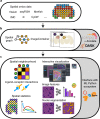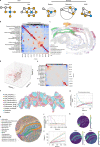Squidpy: a scalable framework for spatial omics analysis
- PMID: 35102346
- PMCID: PMC8828470
- DOI: 10.1038/s41592-021-01358-2
Squidpy: a scalable framework for spatial omics analysis
Abstract
Spatial omics data are advancing the study of tissue organization and cellular communication at an unprecedented scale. Flexible tools are required to store, integrate and visualize the large diversity of spatial omics data. Here, we present Squidpy, a Python framework that brings together tools from omics and image analysis to enable scalable description of spatial molecular data, such as transcriptome or multivariate proteins. Squidpy provides efficient infrastructure and numerous analysis methods that allow to efficiently store, manipulate and interactively visualize spatial omics data. Squidpy is extensible and can be interfaced with a variety of already existing libraries for the scalable analysis of spatial omics data.
© 2022. The Author(s).
Conflict of interest statement
"F.J.T. consults for Immunai Inc., Singularity Bio B.V., CytoReason Ltd, and Omniscope Ltd, and has ownership interest in Dermagnostix GmbH and Cellarity.
Figures




References
-
- Axelrod, S. et al. Starfish: open source image-based transcriptomics and proteomics tools. http://github.com/spacetx/starfish (2018).
Publication types
MeSH terms
Associated data
LinkOut - more resources
Full Text Sources

